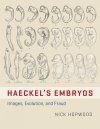"[...] In this sumptuous book, Nick Hopwood, a science historian, examines how and why Haeckel made his drawings, and the use made of them since. His clever detective work takes him into the Haeckel archives in the German town of Jena, discovering the original drawings and even the woodblocks. At the other end of the story, he explores how Haeckel's drawings appeared in postwar textbooks in the UK and the US. [...] Hopwood's excellent, thought-provoking book makes us ponder how these erroneous illustrations acquired their iconic status, and, above all, it shines a spotlight on the power of drawings to influence our thinking."
– Matthew Cobb, New Scientist, 20-01-2015
"Hopwood raises important questions (particularly pertinent to the modern era of viral memes) about the teaching of empirical science and the bringing of complex scientific ideas to the public, the 'boundary of popular literature and specialist work', the relationship between the observer as accurate reporter and as artist, and the line beyond which schematization for didactic or rhetorical effect becomes deliberately misleading."
– Publishers Weekly
"Detailed, well documented, and rich with illustrations. It is likely to be of most value to those with interests in developmental biology, embryology, the history of attacks on evolution, or the history of scientific publication."
– Library Journal
"Rarely have images proved so incendiary as the embryo drawings of nineteenth-century experimental zoologist Ernst Haeckel. In this lavishly illustrated volume, Nick Hopwood traces the chequered history of the sketches, which showed similarities between embryos of higher and lower vertebrates, including humans, at particular points in their development. Haeckel intended the images as support for Charles Darwin's evolutionary theory, but under attack revealed that they were schematics. Hopwood meticulously charts how, despite the controversy, the drawings took on a life of their own."
– Nature
"Ernst Haeckel, the best known German Darwinist of his day, was also the most controversial. For nearly a century and a half his widely circulated series of animal and human embryos, illustrating common descent, have prompted charges of forgery and fraud from scientific, religious, and political critics. Antievolutionists, especially advocates of intelligent design, have been among his most outspoken detractors. One can only hope that Nick Hopwood's scrupulously researched and evenhandedly argued book will finally lay these longstanding controversies to rest."
– Ronald L. Numbers, author of Galileo Goes to Jail and Other Myths about Science and Religion
"Nick Hopwood has written a meticulous and engaging history that sets a high bar for future print and visual culture studies. Haeckel's Embryos shows the material, intellectual, and cultural conditions under which the hidden is rendered visible and the visible rendered standard, amidst contestation at every turn. Open it, and – after you have recovered from its spectacular images – read it, for this is history of science at its best."
– Lynn K. Nyhart, Vilas-Bablitch-Kelch Distinguished Achievement Professor, History of Science, University of Wisconsin–Madison
"Certain images in science capture the imagination and take on a life of their own. In this excellent book, surely the definitive account of the afterlife of scientific images, Nick Hopwood examines the most iconic pictures of vertebrate embryos, those first produced by German evolutionist Ernst Haeckel in 1868. These images have been repeatedly caught up in anti-Darwinist debates and to this day have been subject to charges of scientific fraud. In tracking Haeckel's embryos, Hopwood restores the full sound and fury of history to the act of looking at what humans are and where we came from."
– Trevor Pinch, Cornell University
"Haeckel's Embryos masterfully reconstructs the controversies surrounding Ernst Haeckel's infamous diagrams comparing the embryos of different species. Hopwood's powerful and compelling narrative reveals how Haeckel's diagrams became enmeshed in fundamental questions about visual representation, scientific fraud, relations between science and religion, and interactions between scientists and their publics. Haeckel's Embryos is a transformative study of scientific controversy that should be required reading for every student of science."
– Michael R. Dietrich, coeditor of Outsider Scientists: Routes to Innovation in Biology







































